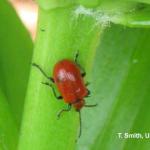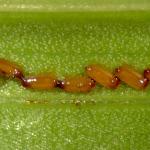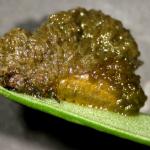Lily Leaf Beetle Lilioceris lilii
Lily Leaf Beetle Lilioceris lilii
Coleoptera: Chrysomelidae
Lily leaf beetle (Lilioceris lilii) is known to lay its eggs and develop only on true lilies, Lilium species (Turk's cap lilies, tiger lilies, Easter lilies, Asiatic and Oriental lilies) (not daylilies), and fritillaria (Fritillaria sp). Although lilies and fritillaria are the primary hosts, lily leaf beetle also feeds, sometimes just lightly, on a number of other plants, including lily of the valley (Convallaria majalis), soloman's seal (Polygonatum sp.), bittersweet (Solanum sp.), potato (Solanum tuberosum), hollyhock (Alcea) and various hosta species. It is however, a devastating pest to true lilies.
History
The lily leaf beetle (LLB) is native to Europe and was discovered near Montreal, Canada in 1945. Its damage was limited to the Montreal area for decades, until discovered in the United States in 1992 in Cambridge, MA. It is thought that LLB arrived in a shipment of lily bulbs from Europe. Since then, LLB has spread throughout much of Massachusetts and is working its way throughout New England. Lily leaf beetles are strong fliers and are also moved from one area to another on host plants. Both the immature stage and adults cause damage by eating the leaves and buds. Adults and larvae are commonly found together devouring lily foliage. Often, they consume all the leaves leaving only bare stems.
Identification and Life Cycle
As soon as lilies break through the ground, over-wintered, bright red adult lily leaf beetles will begin to actively feed on the foliage. The adult beetles are about ½" long with a very bright red body, and black legs, head, antennae, and undersurface. The beetles are foraging for food and seeking a mate. The adult beetles will begin to lay eggs on the undersides of leaves, usually in May. The eggs are irregular-shaped and laid in rows that appear as tan-colored lines. Just before the eggs hatch, they will turn orange and then a deep red color. The eggs hatch within 4-8 days into the immature or larval stage. The larvae are slug-like in appearance with soft, plump orange, brown, yellowish or even greenish bodies and black heads. The young larvae initially feed on the undersides of the foliage but eventually will move to the upper surfaces and the buds. While they feed, the larvae pile their own excrement on their backs which makes them objectionable to hand-pick. The larval feeding is the most destructive and lasts for 16-24 days. The larvae then drop to the soil to pupate. The pupae are bright orange. Adult beetles emerge 16-22 days later and can be seen feeding throughout the rest of the growing season. Adult beetles over-winter in sheltered places, soil or plant debris in the garden or woods, not necessarily near the host plants. Adults prefer areas that are shaded, protected, cool, and moist. The over-wintered adults emerge early in the spring and begin the cycle again with feeding, mating and egg-laying. Each female beetle produces 250-450 eggs.
Management
If you have only have a few plants in the garden, hand-picking adults and eggs can be effective. For more than a few susceptible plants, pesticide treatments may be needed. Products containing Neem (Bon-Neem, Azatin), a botanical insecticide, have been shown to kill very young larvae but must be applied every five to seven days after egg hatch. Products containing spinosad a microbial insecticide, may also be effective. Look on the pesticide label under “active ingredient”. Before recommending a product or applying any pesticide, READ THE LABEL and apply only as directed on the label.
Products containing the systemic imidacloprid have reportedly provided effective control applied either as a foliage spray or soil drench depending on label instructions. Imidacloprid is the active in Merit, used by landscapers and home gardeners and one of the active ingredients in Bayer Advanced Rose and Flower Insect Killer for home gardeners. There are also other home gardener formulations containing imidacloprid. Note that it is thought that imidacloprid is one of the many causes of bee decline and should never be used when bees are active or on plants in flower. See recent research from UMass: Nest Location in Bumble Bees: Effect of Landscapes and Insecticides
When using pesticides it is important to take precautions to protect pollinating insects such as bees. Apply pesticides in the evening when fewer bees will be foraging and when spray drift due to wind and volatilization due to heat are at a minimum. Do not spray during windy weather to prevent drifting. Avoid spraying when plants or nearby plants (including weeds) are in bloom. See the fact sheet "Protecting Bees from Pesticides" (Purdue University).
Lily Leaf Beetle Biological Control Research
Although biological control using parasites are not commercially available, research being conducted by University of Rhode Island have been very promising. Biological control is the using of living organisms (natural enemies) such as insects, mites, fungi or bacteria to control or regulation of pest populations. In the case of LLB, the use of parasitic wasps are being researched.
Parasitic wasps have an immature stage that feeds and develops within a host. The Lily Leaf Beetle is considered the host. The tiny wasp parasitizes the LLB by inserting an egg into the immature stage of the LLB. The wasp larva consumes the LLB slowly and then pupates within the shelter of the LLB’s body, from which it emerges as an adult. In the process of development, the parasitoid saps enough resources from the LLB to kill it.
The University of Rhode Island Biological Control Laboratory, in collaboration with CABI-Bioscience and colleagues in France, identified a complex of four larval parasitoids, which causes a high level of parasitism throughout Europe. On the basis of parasitoid surveys in Europe and laboratory experiments conducted in the USA and Europe, it was determined that these three parasitic wasps Tetrastichus setifer, Lemophagus errabundus, and Diaparsis jucunda were safe and likely candidates to control LLB.
For more information on this research project, see the University of Rhode Island Bio Control Lab.


